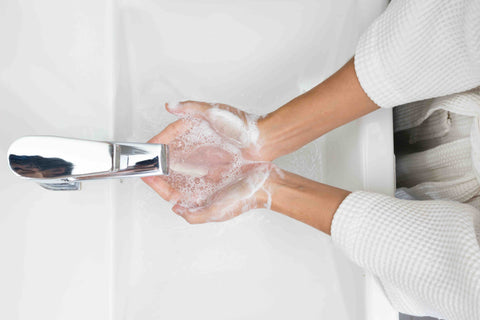How are viruses transmitted?
When we cough or sneeze, microscopic droplets are expelled from our airways and propelled a distance of up to 10 metres. Those droplets land on various surfaces - wood, metal, plastic - which offer virus molecules life spans from a few minutes to several days. If another person comes into contact with that surface, the living virus molecules attach themselves to their skin, which provides the perfect environment for viruses to thrive.
Given that we interact with surfaces primarily with our hands, the infection pathway is quick. It’s estimated that the average person touches their face every two to five minutes, which creates ample opportunity for virus molecules to enter our bodies via the eyes, nostrils or mouth.
How does soap kill bacteria?
We tend to see soap as a feel-good product and focus on its fragrance, texture and soothing properties. But soap is made up of molecules that have a unique natural hybrid structure that destroys and dislodges harmful microorganisms, bacteria and viruses - including coronavirus. How?
Soap molecules have polar ends, being a hydrophilic head and a hydrophobic tail. Essentially, this means that soap molecules behave in a way similar to magnets: one end attracts water, while the other repels water and attracts fat.
Many pathogens, including the virus molecules that make up COVID-19, are coated in a fatty membrane that protects the essential proteins inside. It’s these proteins that allow viruses to survive and infect human cells. When soap is introduced, its hydrophobic tails pierce that fatty membrane, rupturing the virus molecule, spilling its contents, and rendering it useless.
At the same time, soap molecules lift bacteria off the skin by breaking down the chemical bonds that allow microbes to stick to surfaces. This means that when you rinse your hands after washing, the defunct bacteria molecules are washed away with the soap.

Nature meets science
Soap has been around for about 5,000 years: long before science could explain why or how it works. True soap (not hand wash) is still made in the centuries-old traditions of soap making, which is to saponify natural oils with with lye or potash.
Despite its natural origins, soap not only outperforms modern antibacterial hand washes and sanitising formulations, but protects the skin’s natural microbiome. A number of peer-reviewed scientific studies have proven the efficacy of soap, including a 2007 study by Harvard Health, which found that soap’s unique molecular structure is more efficacious than antibacterial hand wash.
Further, a hygiene study conducted by Rutgers University found that water temperature has no impact on eliminating bacteria and pathogens. The determining factor in effective hand hygiene was the use of soap. The same study found that antibacterial formulations did not perform better than soap in removing bacteria from the skin. A 2015 study published in the Journal of Antimicrobial Chemotherapy reported the same findings.
The power is in your hands
Practicing good hand hygiene means washing thoroughly with soap by working up a lather, scrubbing your palms, the backs of your hands and your nails, and interlacing your fingers for a duration of twenty seconds before rinsing and drying hands.
Choose a high quality organic soap to protect against germs without the use of harsh chemicals, which can strip the hands of natural oils and lead to dry, damaged skin.


